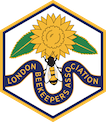
|
London Beekeepers' Association |

|
London Beekeepers' Association |
February in the Apiary[In the apiary, month by month.] Howard Nichols February is a time of increasing activity for the bees. Although cold and rainy on the outside, and, to all appearances all appears to be very quiet, a lot is happening inside the cluster. Brood rearing is increasing and this requires use of additional stores as the temperature in the centre of the cluster is increased from 20°C to 35°C. Bees also consume relatively few stores in Winter but when they start to fly more in late February / early March the consumption substantially increases. Therefore, the main job of the beekeeper is to keep an eye on stores. Bee colonies are more likely to die out in February / early spring due to starvation, not due to the cold. My own personal view is that, as a beekeeper, I make various mistakes but simply letting my bees die of starvation through my neglect should not be one of them. As the weather has been warmer I assessed my colonies on 3rd February. I did not even need to disturb them by opening. They were all flying and bringing in pollen. I took the roof off (but not the crownboard) each colony and lifted the hive. I could tell that 1 colony was light on sugar and so have fed fondant to that 1 colony only at this stage. I intend to take off the mouseguards in next 2 weeks with a view to doing the 1st proper inspection early March if there is a warm day. I went into the winter with 5 colonies and still have 5 colonies which, although good news, is still too early to be confident. February and March are more demanding months than October through to the end of February. The queen will now be laying at an increasing rate. The empty cells inside the cluster will have been prepared and more eggs are being laid. The temperature of a broodless cluster is maintained at 20°C but a cluster with brood requires a 35°C temperature. This, again, also consumes more stores. If feeding is necessary then fondant is still the best bet. If, on a warm day, the bees are flying and emergency stores are required then feeding liquid stores is now a possibility. Bees carry and metabolise nectar at 50\% concentration. 1kg of sugar dissolved in 1 litre of water will give this concentration and so involve the bees in the minimum amount of work. If stores are not required then it is better not to feed at all so not to cause any disturbance. On a warm February day the bees will fly for forage. Main sources in February include snowdrop, crocus and early flowering hazel. The latter provides an abundance of pollen. If your bees have been foraging hazel then they will be coming back to the hive drenched in surplus bright yellow pollen. All these sources provide pollen only. Not nectar. Late February and early March is a challenging time for bees. The winter bees are now old but need to work at an increasing rate to feed larvae and young bees. Many of these older bees will be dying off and a disproportionate number will die in the hive. It is not unusual to find a large quantity of dead bees in front of the hive or behind the mouseguard. Just lift the mouseguard and brush out. This should not normally be cause for concern and does not mean that the colony is dying out. If you keep your hive on a concrete or stone floor then the quantity of dead bees may appear to be alarming. If kept on grass then there may well be just as many dead bees but they will appear substantially less. You may not even notice them at all. Other jobs to doPlan. Formulate an outline plan for the forthcoming season. Have a strategy to develop or improve a particular beekeeping skill during the forthcoming year. Equipment. Assemble frames and ensure you have sufficient equipment for the season. Site. New beekeepers who have not yet found a suitable site should try to do so by the end of the month. Once the beekeeping season starts then life can move at an alarming pace. Meetings. Do not forget the LBKA monthly meetings on the 2nd Sunday of the month. |
©2025 London Beekeepers' Association |